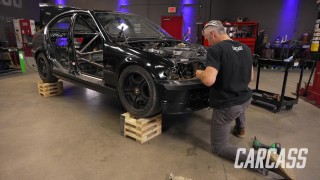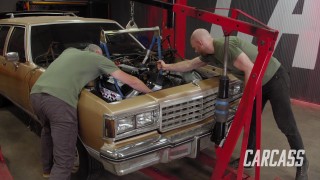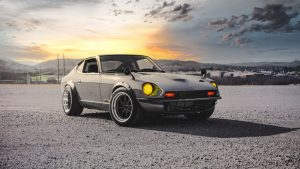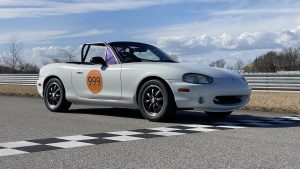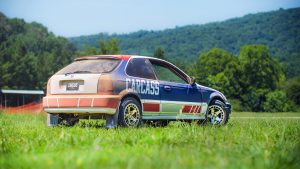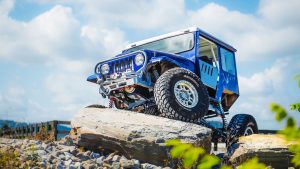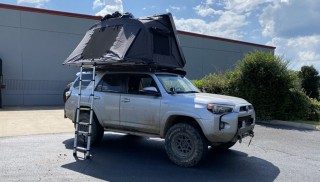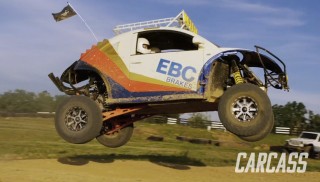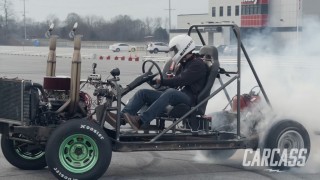Carcass Featured Projects
Carcass Builds
Want more content like this?
Join the PowerNation Email NewsletterEpisode Transcript
(Jeremy)>> You're watching Powernation!
(Jimmy)>> Today on Carcass we stretch out our polycarbonate rear glass on our Road Course Camaro to get an aerodynamic fit.
(Jeremy)>> Then install a major safety feature to give us a few more extra seconds in case of a fire. Plus fabricate a bracket to help us locate our dry sump oil can. [ Music ] [ engine revving ] [ Music ]
(Jeremy)>> Hey everybody, welcome to Carcass. Jimmy and I want to check a bunch of things off the list today cause we are in the final stretch of getting this car running as a complete race car for the very first time.
(Jimmy)>> And all that stuff includes plumbing, all the liquid systems for the engine, fuel, coolant of course, and the oiling system. We also want to show you guys how you can set up a bell housing on your engine for a manual transmission. Something that I think often gets overlooked. Then we're also gonna be getting our rear windshield installed. There are a couple of ways we could go about doing this. The first being installing the original glass, which would be the easiest. However we do see this as another opportunity to save a little bit of weight. So we're gonna make it out of polycarbonate just as we did the front windshield. But we can't just lay the polycarbonate in this original channel because it'll sit will below the surface of the body, and it's not gonna look that good. So what we're gonna do is build a new shelf in this channel for the polycarbonate to sit on top of. That way it'll look really good and it'll be flush with the body and give it a good aerodynamic surface. Something that's gonna help us out with this process are these little pins in this channel. These pins were originally used to hold in the chrome trim pieces for the rear glass, and this will give us a guide of where to put our new shelf. By the time we take into account the thickness of the polycarbonate it should sit just about flush with the body. So to get started here I'm gonna need some steel and a shrinker/stretcher. First thing I did was cut our big piece of metal into a one inch strip, and I'm gonna build this in multiple smaller pieces. I think it'll make it a little bit easier. Basically what we're trying to do is to match the contour of the perimeter of the window opening, and to do that we're gonna be using a shrinker/stretcher. What this does is when you put your piece of metal in it and step on the pedal there's two little jaws that either spread the metal apart or bring it together. That way you can make a compound curve like this to match the outside perimeter of our window. [ Music ] Basically what I'm looking for here as I'm test fitting this is just where the gap starts to form between the strip that I cut and the outside perimeter of this window opening. So wherever that gap starts to open up that's where I'm gonna start placing the next bend. [ Music ] [ grinder buzzing ] [ welder crackling ] [ Music ]
(Jimmy)>> I'm just trying to make sure the gap, if there is one, between the outer windshield frame here is small enough that I can weld it without much trouble. That's a good fit right there. Also just trying to make sure that I hit these other pieces and line them up right so this can look more like it's one piece. Just a little bit of time and patience. Now that I have the new shelf all tacked into place I did go ahead and trim out our new piece of polycarbonate. The way that I did this is I used the stock rear glass as a template, and then it was a very iterative process from there. So there was a lot of back and forth to the car, trimming little areas here and there to get the profile perfect. What I'm gonna do now is actually drill all the mounting holes in this polycarbonate all at once. That way when we start to put the riv nuts in the new shelf we can go ahead and mount it from the center out and really pull this thing into shape. [ Music ] So what I've done here is taken a square and I've set it to the offset that I wanted. That way it makes it easy to trace an entire line around this. This is kind of a complex profile. It's not a perfectly straight line. So this will help make all the marks we need to drill our holes. Now I'm just marking the holes. I'm going five inches apart on these. That's about 25 inches from the edge to the center. So it'll give us four in between. [ drill humming ] [ Music ] [ drill humming ] [ Music ]
(Jimmy)>> I'm ready to put the first rivet nut in here. The way that we're gonna do this is once I get these two rivet nuts in put the piece of poly carbonate back on here, and then we'll just start going each series of holes one by one until we make our way all the way to the outside. The reason for that is if you just try to bend it by hand and mark the holes on the very outside it just doesn't work that well especially with a piece of polycarbonate like this that has pretty extreme curvature it's too difficult to do it by hand to get an accurate placing of the holes. On a flat piece of polycarbonate you can once you get the centers in just mark every hole and drill them, but in this case we're just gonna have to be a little bit patient and take it one by one. [ Music ]
That's pretty much it. We've got all the hardware in it, and now there will be some minor tweaking just to get this thing fitting perfect. As you can see, we're nice and flush at the top here. We're gonna go ahead and chamfer the bottom edge just so it sits down in the channel and clears all those tack welds. Then we'll get some new hardware in it, paint a nice black border on the inside, and call it done!
(Jeremy)>> Fire and race cars don't mix, and coming up we extinguish that threat and show you guys how you can buy yourself more time getting out of your race car safer. [ hissing ]
[ torch hissing ]
(Jeremy)>> Fire is bad! Fire in your race car is even worse, especially if you're trying to get out of your race car safely. Now we don't want you fumbling around trying to grab your fire extinguisher, disconnecting it from the straps so you can get out of the car. Now we're not gonna be using a fire extinguisher like this on our Camaro. What we are gonna be using is a self contained fire suppression system that's designed for race cars and race trucks. This is a Zero-2020 system from Lifeline, and we got this one from Summit Racing. Now this isn't necessarily designed to put out a fire. What it's designed to do is give you more time to exit the car safely without catching yourself on fire. The way that this system all works is you have a bottle or a fire extinguisher, you have some hardlines, and you also have some nozzles and some pull cords that need to be in a very specific area. Jimmy's gonna help me set all of that up.
(Jimmy)>> Like Jeremy said, these need to be mounted in the right locations. Number one, as a driver we need to have a pull handle accessible while we're still strapped in the seat just in the event that our car catches fire. On the other side of things, worst case scenario, if we get into an accident and we're knocked out the fire safety crew has to have another handle accessible from the outside so they can go ahead and pull it, and it gives them time to get us out of the vehicle safely. So while I'm getting these mounted Jeremy's gonna be mounting up the bottle.
(Jeremy)>> So for all of this basically thinking since we have this plate over here we can mount this towards the back. The pull cords, they come in from the bottom side of the extinguisher and then engage in here. That way the cords can come up this direction. Then the nozzle connection is on this side. We can come over here and grab the roll cage tubing and start plumbing in and going wherever we need to go.
(Jimmy)>> We can loop the cables up together. I think we'll have our pull cord right under the digital dash here. Then obviously two nozzles down here pointing a little bit down at our legs. Then an exterior one for the fire crew we'll put it up here on the roll cage, make a plate here, and we'll also put another kill switch out here too.
(Jeremy)>> With this all set up over here this is gonna be pretty basic. I just have to drill a couple of holes. I'll go ahead and drill the holes for this. We'll get this mounted and we'll start plumbing. [ Music ] [ drill humming ] [ Music ]
(Jeremy)>> Alright, I'll just set this right there.
(Jimmy)>> Now it's time to get our mounts for our cable pulls in there. This is just a simple piece with a dimple die. This will go the upper A-pillar area for the fire crew to get their fire pull. Then this piece right here, just broke it three times, blended the welds on the corners. This one will go up under the digital dash so we can reach it while we're sitting in the seat. [ Music ] [ welder crackling ] [ Music ]
(Jimmy)>> Luckily they send you with quite a bit here. So regardless of your application you'll have more than enough length. We can just trim this to fit. One thing to note here too, with this bracket in particular, there is a pilot hole drilled here. We don't know the diameter of what our kill switch will be yet. Once we get there we can just drill it out and get that mounted up as well. So what I'm gonna do here is kinda get these roughed in a little bit. I'm trying to figure out what route we want to take to get to the fire extinguisher bottle. I'm thinking go across the dash bar all the way over to the passenger side. Then drop it down on the floor just to keep everything out of the way. At that point we can trim everything up and finalize these cables. [ Music ]
(Jeremy)>> Now that Jimmy has the pull cords installed on the interior we're gonna move out here to the engine bay and start installing our nozzles. Now the instructions call for these to point towards an ignition source. So something like the fuel rails. Then the way that these spray out it's gonna fall on top of our headers, which is just gonna be a big help as well. The place we're gonna put them is right here on the corner of our roll cage tubing. We took a piece of manilla folder here, traced out a design that we liked, transferred over to a piece of metal here. Then we're just gonna tack this in the corner, and then we'll put our nozzles inside that little hole I have drilled out. Then we'll call that installed. [ Music ]
(Jeremy)>> So once you have your nozzles installed you can grab the supplied tubing, and this is a push lock style. So it just pushes into the back of the nozzle and locks it in place. The tubing itself is an aluminum tubing wrapped in plastic, and it's quite pliable. You can bend it and it retains its shape very well. So we'll be able to graft it around and put it where we need to put it. We've got two more to put into the engine bay here for a total of three in the engine bay. We've got two nozzles that need to go into the car for a grand total of five. Once all that's installed we'll check a major thing off the safety list. Coming up, we install a huge oil tank for our dry sump oil system.
(Jeremy)>> So we have our fire suppression system mounted in the passenger compartment and sticking with that theme we're gonna mount a couple more things on the car to get it further along. The engine that Engine Power built us has a dry sump oil system. So there is a giant oil tank that we have to mount, and the best spot we could find for this is back here in between the two firewalls that Jimmy and I have already built. This just keeps the tank itself safe and it keeps us safe just in case we have an oil leak and we don't want to get hot oil all over Jimmy and myself. So this did come with a mount, or at least a mount that Engine Power used on the dyno. We can't use this mount but the basic idea of it is what I'm gonna copy. So what we're gonna do is get this into place here. I'll take a couple of measurements. We'll copy that mount onto some steel and we'll get this thing mounted up. We're at about an inch and three quarter. [ saw buzzing ]
(Jeremy)>> Now that we have the little standoff made we're gonna end up cutting this piece of the bracket out. I'm gonna do it on this piece of eighth inch plate steel. The measurements we're gonna use for this are three inches wide by about eight inches long. [ Music ] [ saw buzzing ] [ Music ]
(Jeremy)>> Ow, that landed on my foot! To get this into shape, that half moon shape that we need, we're gonna use something called a slip roller. The way that this works is you've got two adjustments on the back here and it decreases the distance between the rollers. What that does is put pressure on the rollers themselves, and then the more you go back forth it will start taking shape here kinda like that half moon we're going for. With this being eighth inch plate steel this is gonna take quite a bit of rolling because it's so thick and heavy. We'll sneak up on it and we'll get there. [ Music ]
So we have our piece made here on the slip roller and it first this tank really well. Now what we'll do is take the standoff, get that up here on the roll cage tubing. Then we'll put our piece we just made on the roller in here, and then the challenge will be getting this all set in here and making sure everything's level. Then we'll tack everything together. [ welder crackling ] [ Music ] [ welder crackling ]
(Jeremy)>> Now that we have the bracket all welded up I did choose to just do it over here on the table because it was just gonna be a bear to weld on the bottom side of it. Just makes life a lot easier. We'll go ahead and place it all over here on our oil tank, and then we will get this loosely bolted into place. Then we'll go back over to the car and tack it back in. [ Music ] [ ratchet clicking ] [ Music ] [ welder crackling ]
(Jeremy)>> Like I said earlier, we're gonna be running a dry sump oil system in our Camaro, and the way that differs from a traditional oiling system is in a traditional system you have an oil pan, which houses all of your oil, an oil pump, and you have a pickup tube. That works fine in your everyday ordinary driving vehicles, but for us in our Camaro when we get out onto the racetrack we can encounter so G-forces that could actually slosh that oil to one side of the oil pan, uncovering our pickup tube, and that can starve our engine of oil. Now that slosh can also get up into your rotating assembly, which is called windage, and that windage could actually rob you of horsepower. The way you get away from that windage is to remove all the extra oil from the oil pan and put it into an external oil tank like we mounted on our Camaro. When you get away from all that extra oil in the pan you can actually go to a smaller oil pan, but that poses a little bit of an issue because then you can't run an internal oil pump on your engine. So a solution to that is to run an external oil pump for your dry sump system. The reason why it's called a dry sump is that the smaller oil pan is tentatively dry and the external pump scavenges or removes the oil from the oil pan and gets it to and from the remote tank. The pump we're using is a Moroso five stage oil pump that uses four stages to scavenge oil from the oil pan and one stage to deliver oil to the storage tank and send it back through the engine. By running a system like this we get three major advantages. One, we don't risk starving the engine of any oil. Two, by running a smaller oil pan it allowed us to set the engine lower in the car and that will increase our handling. And three, by getting rid of that windage we were able to pick up a little more horsepower.
(Jimmy)>> We mockup the race clutch setup to show you how to measure for a release bearing.
(Jimmy)>> Race cars are pretty cool because they use a lot of parts that we don't really get to see outside the very specific world of racing. One example of that on our car is the clutch system. This is a Quartermaster three-disc clutch and it has quite a few differences than even the highest performance street clutches that you might see out there. The biggest difference being the overall diameter and the materials used. As you can see, this clutch is very small at only seven and a quarter inches and the disc material is a centered metallic type. Whereas on a street clutch you're gonna be more into the 10-to-11-inch range and the disc is either gonna be organic or a combination of organic and metallic materials. Small clutches are great for race cars because it allows the engine to spin up quite a bit faster, and if your tires can hold it that means you can accelerate faster. The downside to a clutch like this on the street is there's not a whole lot of inertia to keep the engine running when you go to release the clutch and take off. That's why street clutches tend to have really big, heavy flywheels, so you can get that gradual transition and give yourself a smooth takeoff. The other downside to a metallic clutch is that they don't deal with heat too well. When you start to grind them and they generate a lot of heat they can wear out very quickly. Whereas an organic compound is made to take the abuse from the heat. So if you're in stop and go traffic it can handle it without much problem. I'm just trying to mock this up here so we can get some measurements for our release bearing. I'll go ahead, throw this up here, and start taking some measurements. [ Music ] Not too worried about getting everything torqued down right now. We're just trying to get this mocked up so we can take a couple of measurements. [ Music ] [ ratchet clicking ] [ Music ]
(Jimmy)>> So what I'm gonna try to measure here is from the fingers of the pressure plate to the back of the bell housing, which is three and a quarter, but I have to subtract the distance from the back of the bell housing to the mounting pad of the release bearing. So three and a quarter. That's 1.120. So that's gonna be 2.13 inches, and then we're also shooting for two hundred thousandths gap to allow for clutch wear. So that'll give us 1.93 inches height in our release bearing. So we'll go ahead and get that ordered, and then we can do final assembly. In the meantime we still have a lot of work to do. So we'll catch you guys next time.
Show Full Transcript
(Jimmy)>> Today on Carcass we stretch out our polycarbonate rear glass on our Road Course Camaro to get an aerodynamic fit.
(Jeremy)>> Then install a major safety feature to give us a few more extra seconds in case of a fire. Plus fabricate a bracket to help us locate our dry sump oil can. [ Music ] [ engine revving ] [ Music ]
(Jeremy)>> Hey everybody, welcome to Carcass. Jimmy and I want to check a bunch of things off the list today cause we are in the final stretch of getting this car running as a complete race car for the very first time.
(Jimmy)>> And all that stuff includes plumbing, all the liquid systems for the engine, fuel, coolant of course, and the oiling system. We also want to show you guys how you can set up a bell housing on your engine for a manual transmission. Something that I think often gets overlooked. Then we're also gonna be getting our rear windshield installed. There are a couple of ways we could go about doing this. The first being installing the original glass, which would be the easiest. However we do see this as another opportunity to save a little bit of weight. So we're gonna make it out of polycarbonate just as we did the front windshield. But we can't just lay the polycarbonate in this original channel because it'll sit will below the surface of the body, and it's not gonna look that good. So what we're gonna do is build a new shelf in this channel for the polycarbonate to sit on top of. That way it'll look really good and it'll be flush with the body and give it a good aerodynamic surface. Something that's gonna help us out with this process are these little pins in this channel. These pins were originally used to hold in the chrome trim pieces for the rear glass, and this will give us a guide of where to put our new shelf. By the time we take into account the thickness of the polycarbonate it should sit just about flush with the body. So to get started here I'm gonna need some steel and a shrinker/stretcher. First thing I did was cut our big piece of metal into a one inch strip, and I'm gonna build this in multiple smaller pieces. I think it'll make it a little bit easier. Basically what we're trying to do is to match the contour of the perimeter of the window opening, and to do that we're gonna be using a shrinker/stretcher. What this does is when you put your piece of metal in it and step on the pedal there's two little jaws that either spread the metal apart or bring it together. That way you can make a compound curve like this to match the outside perimeter of our window. [ Music ] Basically what I'm looking for here as I'm test fitting this is just where the gap starts to form between the strip that I cut and the outside perimeter of this window opening. So wherever that gap starts to open up that's where I'm gonna start placing the next bend. [ Music ] [ grinder buzzing ] [ welder crackling ] [ Music ]
(Jimmy)>> I'm just trying to make sure the gap, if there is one, between the outer windshield frame here is small enough that I can weld it without much trouble. That's a good fit right there. Also just trying to make sure that I hit these other pieces and line them up right so this can look more like it's one piece. Just a little bit of time and patience. Now that I have the new shelf all tacked into place I did go ahead and trim out our new piece of polycarbonate. The way that I did this is I used the stock rear glass as a template, and then it was a very iterative process from there. So there was a lot of back and forth to the car, trimming little areas here and there to get the profile perfect. What I'm gonna do now is actually drill all the mounting holes in this polycarbonate all at once. That way when we start to put the riv nuts in the new shelf we can go ahead and mount it from the center out and really pull this thing into shape. [ Music ] So what I've done here is taken a square and I've set it to the offset that I wanted. That way it makes it easy to trace an entire line around this. This is kind of a complex profile. It's not a perfectly straight line. So this will help make all the marks we need to drill our holes. Now I'm just marking the holes. I'm going five inches apart on these. That's about 25 inches from the edge to the center. So it'll give us four in between. [ drill humming ] [ Music ] [ drill humming ] [ Music ]
(Jimmy)>> I'm ready to put the first rivet nut in here. The way that we're gonna do this is once I get these two rivet nuts in put the piece of poly carbonate back on here, and then we'll just start going each series of holes one by one until we make our way all the way to the outside. The reason for that is if you just try to bend it by hand and mark the holes on the very outside it just doesn't work that well especially with a piece of polycarbonate like this that has pretty extreme curvature it's too difficult to do it by hand to get an accurate placing of the holes. On a flat piece of polycarbonate you can once you get the centers in just mark every hole and drill them, but in this case we're just gonna have to be a little bit patient and take it one by one. [ Music ]
That's pretty much it. We've got all the hardware in it, and now there will be some minor tweaking just to get this thing fitting perfect. As you can see, we're nice and flush at the top here. We're gonna go ahead and chamfer the bottom edge just so it sits down in the channel and clears all those tack welds. Then we'll get some new hardware in it, paint a nice black border on the inside, and call it done!
(Jeremy)>> Fire and race cars don't mix, and coming up we extinguish that threat and show you guys how you can buy yourself more time getting out of your race car safer. [ hissing ]
[ torch hissing ]
(Jeremy)>> Fire is bad! Fire in your race car is even worse, especially if you're trying to get out of your race car safely. Now we don't want you fumbling around trying to grab your fire extinguisher, disconnecting it from the straps so you can get out of the car. Now we're not gonna be using a fire extinguisher like this on our Camaro. What we are gonna be using is a self contained fire suppression system that's designed for race cars and race trucks. This is a Zero-2020 system from Lifeline, and we got this one from Summit Racing. Now this isn't necessarily designed to put out a fire. What it's designed to do is give you more time to exit the car safely without catching yourself on fire. The way that this system all works is you have a bottle or a fire extinguisher, you have some hardlines, and you also have some nozzles and some pull cords that need to be in a very specific area. Jimmy's gonna help me set all of that up.
(Jimmy)>> Like Jeremy said, these need to be mounted in the right locations. Number one, as a driver we need to have a pull handle accessible while we're still strapped in the seat just in the event that our car catches fire. On the other side of things, worst case scenario, if we get into an accident and we're knocked out the fire safety crew has to have another handle accessible from the outside so they can go ahead and pull it, and it gives them time to get us out of the vehicle safely. So while I'm getting these mounted Jeremy's gonna be mounting up the bottle.
(Jeremy)>> So for all of this basically thinking since we have this plate over here we can mount this towards the back. The pull cords, they come in from the bottom side of the extinguisher and then engage in here. That way the cords can come up this direction. Then the nozzle connection is on this side. We can come over here and grab the roll cage tubing and start plumbing in and going wherever we need to go.
(Jimmy)>> We can loop the cables up together. I think we'll have our pull cord right under the digital dash here. Then obviously two nozzles down here pointing a little bit down at our legs. Then an exterior one for the fire crew we'll put it up here on the roll cage, make a plate here, and we'll also put another kill switch out here too.
(Jeremy)>> With this all set up over here this is gonna be pretty basic. I just have to drill a couple of holes. I'll go ahead and drill the holes for this. We'll get this mounted and we'll start plumbing. [ Music ] [ drill humming ] [ Music ]
(Jeremy)>> Alright, I'll just set this right there.
(Jimmy)>> Now it's time to get our mounts for our cable pulls in there. This is just a simple piece with a dimple die. This will go the upper A-pillar area for the fire crew to get their fire pull. Then this piece right here, just broke it three times, blended the welds on the corners. This one will go up under the digital dash so we can reach it while we're sitting in the seat. [ Music ] [ welder crackling ] [ Music ]
(Jimmy)>> Luckily they send you with quite a bit here. So regardless of your application you'll have more than enough length. We can just trim this to fit. One thing to note here too, with this bracket in particular, there is a pilot hole drilled here. We don't know the diameter of what our kill switch will be yet. Once we get there we can just drill it out and get that mounted up as well. So what I'm gonna do here is kinda get these roughed in a little bit. I'm trying to figure out what route we want to take to get to the fire extinguisher bottle. I'm thinking go across the dash bar all the way over to the passenger side. Then drop it down on the floor just to keep everything out of the way. At that point we can trim everything up and finalize these cables. [ Music ]
(Jeremy)>> Now that Jimmy has the pull cords installed on the interior we're gonna move out here to the engine bay and start installing our nozzles. Now the instructions call for these to point towards an ignition source. So something like the fuel rails. Then the way that these spray out it's gonna fall on top of our headers, which is just gonna be a big help as well. The place we're gonna put them is right here on the corner of our roll cage tubing. We took a piece of manilla folder here, traced out a design that we liked, transferred over to a piece of metal here. Then we're just gonna tack this in the corner, and then we'll put our nozzles inside that little hole I have drilled out. Then we'll call that installed. [ Music ]
(Jeremy)>> So once you have your nozzles installed you can grab the supplied tubing, and this is a push lock style. So it just pushes into the back of the nozzle and locks it in place. The tubing itself is an aluminum tubing wrapped in plastic, and it's quite pliable. You can bend it and it retains its shape very well. So we'll be able to graft it around and put it where we need to put it. We've got two more to put into the engine bay here for a total of three in the engine bay. We've got two nozzles that need to go into the car for a grand total of five. Once all that's installed we'll check a major thing off the safety list. Coming up, we install a huge oil tank for our dry sump oil system.
(Jeremy)>> So we have our fire suppression system mounted in the passenger compartment and sticking with that theme we're gonna mount a couple more things on the car to get it further along. The engine that Engine Power built us has a dry sump oil system. So there is a giant oil tank that we have to mount, and the best spot we could find for this is back here in between the two firewalls that Jimmy and I have already built. This just keeps the tank itself safe and it keeps us safe just in case we have an oil leak and we don't want to get hot oil all over Jimmy and myself. So this did come with a mount, or at least a mount that Engine Power used on the dyno. We can't use this mount but the basic idea of it is what I'm gonna copy. So what we're gonna do is get this into place here. I'll take a couple of measurements. We'll copy that mount onto some steel and we'll get this thing mounted up. We're at about an inch and three quarter. [ saw buzzing ]
(Jeremy)>> Now that we have the little standoff made we're gonna end up cutting this piece of the bracket out. I'm gonna do it on this piece of eighth inch plate steel. The measurements we're gonna use for this are three inches wide by about eight inches long. [ Music ] [ saw buzzing ] [ Music ]
(Jeremy)>> Ow, that landed on my foot! To get this into shape, that half moon shape that we need, we're gonna use something called a slip roller. The way that this works is you've got two adjustments on the back here and it decreases the distance between the rollers. What that does is put pressure on the rollers themselves, and then the more you go back forth it will start taking shape here kinda like that half moon we're going for. With this being eighth inch plate steel this is gonna take quite a bit of rolling because it's so thick and heavy. We'll sneak up on it and we'll get there. [ Music ]
So we have our piece made here on the slip roller and it first this tank really well. Now what we'll do is take the standoff, get that up here on the roll cage tubing. Then we'll put our piece we just made on the roller in here, and then the challenge will be getting this all set in here and making sure everything's level. Then we'll tack everything together. [ welder crackling ] [ Music ] [ welder crackling ]
(Jeremy)>> Now that we have the bracket all welded up I did choose to just do it over here on the table because it was just gonna be a bear to weld on the bottom side of it. Just makes life a lot easier. We'll go ahead and place it all over here on our oil tank, and then we will get this loosely bolted into place. Then we'll go back over to the car and tack it back in. [ Music ] [ ratchet clicking ] [ Music ] [ welder crackling ]
(Jeremy)>> Like I said earlier, we're gonna be running a dry sump oil system in our Camaro, and the way that differs from a traditional oiling system is in a traditional system you have an oil pan, which houses all of your oil, an oil pump, and you have a pickup tube. That works fine in your everyday ordinary driving vehicles, but for us in our Camaro when we get out onto the racetrack we can encounter so G-forces that could actually slosh that oil to one side of the oil pan, uncovering our pickup tube, and that can starve our engine of oil. Now that slosh can also get up into your rotating assembly, which is called windage, and that windage could actually rob you of horsepower. The way you get away from that windage is to remove all the extra oil from the oil pan and put it into an external oil tank like we mounted on our Camaro. When you get away from all that extra oil in the pan you can actually go to a smaller oil pan, but that poses a little bit of an issue because then you can't run an internal oil pump on your engine. So a solution to that is to run an external oil pump for your dry sump system. The reason why it's called a dry sump is that the smaller oil pan is tentatively dry and the external pump scavenges or removes the oil from the oil pan and gets it to and from the remote tank. The pump we're using is a Moroso five stage oil pump that uses four stages to scavenge oil from the oil pan and one stage to deliver oil to the storage tank and send it back through the engine. By running a system like this we get three major advantages. One, we don't risk starving the engine of any oil. Two, by running a smaller oil pan it allowed us to set the engine lower in the car and that will increase our handling. And three, by getting rid of that windage we were able to pick up a little more horsepower.
(Jimmy)>> We mockup the race clutch setup to show you how to measure for a release bearing.
(Jimmy)>> Race cars are pretty cool because they use a lot of parts that we don't really get to see outside the very specific world of racing. One example of that on our car is the clutch system. This is a Quartermaster three-disc clutch and it has quite a few differences than even the highest performance street clutches that you might see out there. The biggest difference being the overall diameter and the materials used. As you can see, this clutch is very small at only seven and a quarter inches and the disc material is a centered metallic type. Whereas on a street clutch you're gonna be more into the 10-to-11-inch range and the disc is either gonna be organic or a combination of organic and metallic materials. Small clutches are great for race cars because it allows the engine to spin up quite a bit faster, and if your tires can hold it that means you can accelerate faster. The downside to a clutch like this on the street is there's not a whole lot of inertia to keep the engine running when you go to release the clutch and take off. That's why street clutches tend to have really big, heavy flywheels, so you can get that gradual transition and give yourself a smooth takeoff. The other downside to a metallic clutch is that they don't deal with heat too well. When you start to grind them and they generate a lot of heat they can wear out very quickly. Whereas an organic compound is made to take the abuse from the heat. So if you're in stop and go traffic it can handle it without much problem. I'm just trying to mock this up here so we can get some measurements for our release bearing. I'll go ahead, throw this up here, and start taking some measurements. [ Music ] Not too worried about getting everything torqued down right now. We're just trying to get this mocked up so we can take a couple of measurements. [ Music ] [ ratchet clicking ] [ Music ]
(Jimmy)>> So what I'm gonna try to measure here is from the fingers of the pressure plate to the back of the bell housing, which is three and a quarter, but I have to subtract the distance from the back of the bell housing to the mounting pad of the release bearing. So three and a quarter. That's 1.120. So that's gonna be 2.13 inches, and then we're also shooting for two hundred thousandths gap to allow for clutch wear. So that'll give us 1.93 inches height in our release bearing. So we'll go ahead and get that ordered, and then we can do final assembly. In the meantime we still have a lot of work to do. So we'll catch you guys next time.







